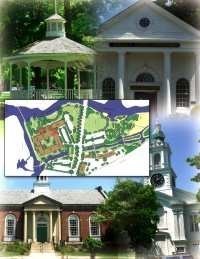
Until recently, Massachusetts encouraged the development of affordable housing through Chapter 40B, an unpopular law characterized by critics as a sledgehammer that allows developers to bypass local zoning laws and build developments that many towns view as large, inappropriate, and sometimes unwanted.
Whether to temper the dislike of 40B or to provide a "carrot" to the counterbalance the heavy stick of that legislation, the state Legislature in 2004 passed Chapter 40R, a groundbreaking law that promotes affordable housing through the alternative "Smart Growth Overlay Districts."
Smart Growth Details Are Key
Smart growth overlay districts are intended to decrease urban sprawl though the encouragement of mixed-use developments that are close to public transportation, or are located in areas that are deemed appropriate for higher density developments.
Smart growth districts under 40R—just like the requirements set by Chapter 40B—still mandate that 20 percent of the units be dedicated to affordable housing, but the array of benefits to towns make 40Rs far more desirable than 40Bs.
In stark contrast to 40Bs, 40R (and its companion legislation, 40S) awards cities and towns substantial cash payments for allowing development, along with a large degree of input into the development. Highlighting a town's input into a 40R is its role as applicant for the zoning change, and the fact that the town must approve the creation of the 40R smart growth district by a majority vote of two-thirds during a town or city council meeting.
Making 40Rs politically popular, and relatively easy to pass at town meetings, are their role in producing affordable housing units that count toward the state's affordable housing requirements. In Massachusetts, unless 10 percent of a town's housing is deemed affordable, the town is virtually powerless to block unwanted 40B developments. If, however, the town should reach the 10 percent mark—say, through approving a more desirable 40R development—it is immune from future 40B developments, an overriding motivation for many communities.
Compare and Contrast
The relationship between 40R and 40B is often likened to a carrot and a stick, according to Donald Schmidt, director of Smart Growth Planning at the state Department of Housing and Community Development (DHCD), which oversees the 40R program.
"For most of the communities, it's really about meeting their obligations under 40B," says Schmidt, referring to the motivations of many of the 16 cities and towns across Massachusetts which had approved 40Rs on 743 acres total as of May.
Also making 40Rs more attractive than 40Bs are the variety of financial incentives that accrue to the towns under the statute. Under 40R, towns receive cash payments from the state when successive development milestones are passed, like the issuance of building permits. The town of Amesbury, for instance, is slated to receive $1.3 million from the state for Gateway Village, a 225-unit development on 52 acres.
In addition, towns also receive a permanent annual reimbursement from the state to cover the increased cost of educating the children who will likely call the new developments home. In the past, increased educational costs have fed opposition to both conventional and 40B developments.
Under the 40R formula, increases in education costs that are not offset by new property and excise taxes in the smart growth district are directly reimbursed to towns through increased local aid payments from the state, also known as "cherry sheets."
Says Schmidt, "40R is a kind of an insurance policy. What I mean by that is that 40R protects a community in a situation where [additional] educational costs from the district do not meet the projected [increased] revenues."
Location, Location, Location
Another benefit of 40R developments is that unlike conventional 40B development—which is typically sited according to a developer's wishes—40Rs are situated on three types of locations: near mass transit, in "areas of concentrated development," and in a "highly suitable location." All of these sites are seen as beneficial to towns because the growth is consolidated in a more appropriate area, often in an area that is underutilized or blighted.
In Grafton, Massachusetts, for example, town voters unanimously approved a 40R on the site of a former burned-out factory along the Blackstone River.
The 240-unit Fisherville Mill site was designated as "highly suitable" because the area had been suffering with a high level of "dis-investment" as old factories along the Blackstone River went out of business and property values plummeted, says Grafton Town Planner Stephen Bishop.
An even more serious problem was that the site had been contaminated with toxic chemicals after a 1999 fire that nearly destroyed the building. Even more worrisome, the chemicals contaminated local ground water. Eugene Bernat, vice president of Cover Technologies of Springfield, Massachusetts, which is developing Fisherville Mill, says the EPA and his firm have spent more than $4 million cleaning up the site.
Bernat says his firm sold the 40R to town meeting voters by presenting them with a stark contrast. "You can have urban blight in the community or you can have a redeveloped, viable town center. That's a pretty obvious choice."
In addition to the reclamation of a site that no one else would touch, town voters also secured other valuable items in Fisherville Mill.
Half of the site's 32 acres will be converted into a public park, allowing access to a bike path and recreation area being developed along the Blackstone River and Canal.
Also attractive to the town, says Bernat, was Grafton's desire to accumulate affordable housing units to fend off 40Bs. "Like most towns, they're being faced with hostile 40Bs," he says.
Cover Technologies is currently planning to erect 240 units of residential housing and 60,000 square feet of commercial space on the site. If the real estate market is still soft when the project is finished, Cover Technologies will consider developing all 240 units as rentals, which would be "an enormous coup to the community," says Bernat, who notes that 100 percent of rental units count toward 40B requirements.
If all the Fisherville Mill units are rental, Grafton would be "very close" to fulfilling its 40B requirements, says Bishop.
A final benefit to Grafton is the nearly $1 million in bonus payments the town will receive for allowing the project to go forward, says Bernat.
In Lunenburg, a dilapidated drive-in theater has also been designated as a highly desirable location for a 40R. That town is slated to receive about $962,000 from the state when its 204 multi-family residences are erected by Massachusetts Housing Opportunities Corp. of North Andover. It is highly likely that this development's 204 units will also be dedicated to rental use. If so, when they are combined with the existing affordable units in Lunenburg, the 40R will shield the town from any future 40B developments.
Market Pressures Have an Effect
Despite the advantages of 40Rs, there are indications that these developments are affected by the same market forces that pressure conventional developments.
In Gardner, a 40R with a mix of retail and residential is being restructured to reflect the slower real estate market, according to developer Martin Wolons, president of the Vertical Building Group of Hubbardston, Massachusetts.
Under a modified plan in the works, Wachusett Meadows will be reduced from about 650 residential units to 300, says Wolons. The retail portion of the 40R project, Wachusett Crossing, will be doubled to take advantage of increased retail opportunities on the 114-acre site off Routes 140 and 101.
"You're talking about a [residential/retail] flip-flop because the retail market is doing better," says Wolons.
Wolons says he expects to break ground about 18 months from now, after first securing approval for changes to his 40R.
A Bright Future
Despite the scaling back of the Gardner project, and the a perception that developers and towns haven't yet fully embraced 40R, smart growth districts still have a bright future, says attorney Matthew J. Lawlor, a senior associate with Robinson & Cole, LLP, of Boston, Massachusetts, who has worked extensively on affordable housing issues.
"One thing I think we have to realize is the market has slowed, and the number of 40R developments has slowed as well. It may be more a reflection of the overall market.
"I think the hope of everyone who thinks that 40R has some promise is that communities—once they get more comfortable or see that denser multiple or single-family housing is not the end of the world, [and] that in fact it can appreciably improve a community—having taken the incentives, they'll do more of this."






Leave a Comment